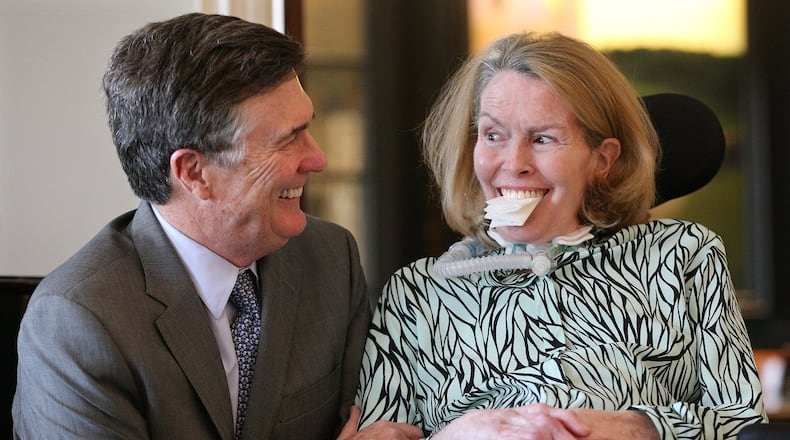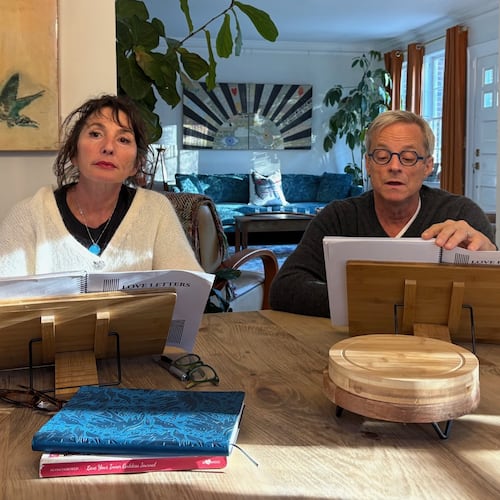Mary Rose Taylor is typing with her right thumb.
One letter at a time, she explains herself, touching the screen on her iPhone with the only digit that works, carefully shifting for capital letters and punctuation. Her Buckhead condominium is quiet but for the hiss of the portable ventilator, automatically inflating her lungs every three seconds.
The compact breathing machine is packed under her motorized wheelchair, attached to a hole in her throat with an accordionated plastic tube. Her thumb, not completely under her control, sometimes drags on the wrong letter, and she goes back and starts over.
Is it tedious to communicate one letter at a time? Her eyes sparkle. With the driest of humor she types, “It requires more patience for the listeners.”
She keeps writing: “It requires tremendous focus but thankfully that comes easily to me.”
The third chapter of Mary Rose Taylor’s life is winding toward a denouement, and she is as focused as a gamma knife.
Alzheimer's, the disease that took her second husband, developer Mack Taylor, prompted her to devote her life to fighting that illness, Parkinson's and other intractable neurological disorders. She directed time, resources and her networking ability toward helping Dr. Allan Levey and the Emory University Department of Neurology rise to the challenge.
Then in 2014, she began experiencing worrying problems— difficulty swallowing, a forgotten word. Her friend Jonathan Glass, who is also director of Emory's ALS Center, sat across from her at a Starbucks and recognized the symptoms.
She was diagnosed that October with ALS, amyotrophic lateral sclerosis, also called Lou Gehrig’s disease. She became a patient at Emory’s Brain Health Center, a place that she had championed. Soon she would lose the ability to walk, to speak, to swallow and, eventually, to breathe. In January, she made the difficult decision to undergo a tracheostomy as her muscles weakened.
But with her mobility reduced to the use of a single finger, her determination to assist the Brain Health Center never flagged. The center is a unique organization that puts under one roof treatment of — and research into — the major neurodegenerative diseases.
“There would not be a Brain Health Center today if Mary had not been a founding partner, a co-conspirator, an inspiration and an instigator,” said Levey. “She came up with the name.”
Her third husband, Dennis Lockhart, said she still sends emails, holds meetings and communicates with the center’s leaders to strategize. The center recognized her contribution by naming its new lobby the Mary Rose Taylor Family Lobby.
“She’s still trying to be the impresario,” said Lockhart, who in February retired from the Federal Reserve Bank of Atlanta, where he was president and CEO. He is also chair of the advisory board for the Brain Health Center. The couple lives in the condo she once shared with Mack Taylor, adorned with the developer’s Audubon prints, big game trophies and a Steinway baby grand.
She won’t stop. That’s a feature of the Mary Rose Taylor personality: indomitable drive in the face of significant obstacles.
Back in the 1990s, that personality came to the fore during her long campaign to rescue the house where Margaret Mitchell wrote Atlanta’s most famous book, “Gone with the Wind.”
Burned by arsonists, threatened by the wrecking ball, the Midtown apartment house was a shambles when Taylor arranged financing and lined up allies in 1994. The house museum was fully renovated and ready to open its doors in time for the 1996 Olympics — Atlanta’s big coming out party — when arsonists burned it again.
Taylor dusted herself off and started over. Rebuilt a second time, the house opened to the public a year later. Only one part of the building was truly historic, the ground-floor rooms where Mitchell did her writing, and that's the part that, miraculously, was unscathed in the multiple fires.
“Talk about resiliency,” said Sheffield Hale, president and CEO of the Atlanta History Center, which now manages the Margaret Mitchell House. “The book (“Gone with the Wind”) is about resilience and the city has always been about that, and Mary has always personified that.”
The city is also attuned to racism, and the stereotyped black characters in the book turned many leaders against Taylor's project. That attitude softened slightly when it was revealed that, during the 1940s, Mitchell had quietly paid the tuition at Morehouse College for at least 20 black medical students.
This complex history creates a forum for conversations about race that might not otherwise happen, said Hale. “It adds a little kernel irritation … that is helpful to the discussion.”
Credit: JEAN SHIFRIN
Credit: JEAN SHIFRIN
This was Mary Rose Taylor’s second chapter. Her first chapter, after divorcing television personality Charlie Rose and moving to Atlanta, was as a journalist on WXIA television. Among her admirers was Lockhart, a banker who, though happily married, could still appreciate the charms of an attractive newswoman during evening broadcasts.
In 1980, she actually interviewed him for one of her first stories for the station, a story about the deceptive prime rate. “I told my secretary I will definitely take that call,” said Lockhart.
Lockhart’s wife died of a brain tumor in 2000. Mack Taylor died in 2008. Dennis called Mary two years later, but she said it was too soon. Some time after that, they began seeing each other.
In December of 2014, they were married, about two months after she was diagnosed with ALS.
When Glass,Taylor’s doctor, told her last fall she needed to consider resorting to a ventilator, she refused. “My personal affairs were in order and I said no,” she writes in an email. “I had grown up in a medical family where issues of life and death were openly discussed. I was at peace with death and did not want to extend my life by artificial means.”
Lockhart changed her mind.
“My husband felt differently,” she writes. “He said he needed me and that despite my condition I still had much to offer our community. It was a very emotional conversation. I could not comprehend that this extraordinary man, my best friend, could still want me under these conditions.
“In the early months after my diagnosis,” she writes, “I would wake up feeling the weight of depression, and I would physically push it out of the way, saying, ‘I don’t have time for this. I have too much to do.’ Then I would feel the strength of my husband’s spirit and feel renewed.”
Levey points out that many older Americans who die have evidence of neurological damage in their brains, but never show symptoms. Why?
It turns out that “what is protecting people from common age-related pathologies is a purpose in life,” he said. “And if there is one person who epitomizes a purpose in life, who is it? It’s Mary.”
Taylor’s determination to get the Brain Health Center on its feet, in other words, is contributing to her own brain health. Her brain, in fact, still works fine. “She’s passionate,” said Glass. “I mean the woman still does Pilates.” (In addition to her caregivers, she is assisted by a trainer who comes to the condo daily and helps move her arms and legs to keep them flexible.)
“Many friends ask, ‘don’t you ever question why me?’” she writes before answering the question. “Absolutely not. I have had a blessed life. This is just part of my journey. Apparently God has more ‘teachable moments’ for me.”
About the Author
Keep Reading
The Latest
Featured







